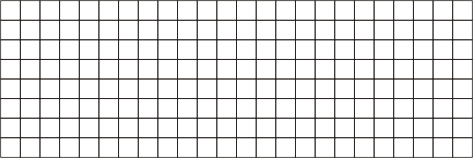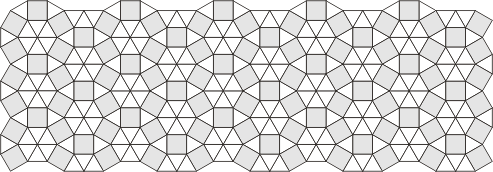Wikipedia gives the following definition:
in recreational mathematics, a polyform is a plane figure
constructed by joining together identical basic polygons.
There are many of these strange
mathematical creatures out there, and I have been unable to find
a comprehensive bestiary so I decided to make one myself. In the
process, I discovered that there are infinite numbers of
different shapes that can be used, so the list will not be
complete. Nevertheless, I hope it provides a useful resource.
The unit is the original polygon
which is used to generate the pieces.
The order of a polyform is the number of
unit shapes needed to construct it.
Generally, polyforms may be rotated and
turned over (reflected). One-sided polyforms comprise
sets which contain mirror duplicates of all pieces that are not
already symmetric in a mirror. Using these sets, the pieces may
only be rotated.
The set of pieces used in any puzzle
should be clearly specified. Sets may be: all pieces of a given
order; complete sets of several orders; multiple copies of a
single tile; or a purely arbitrary selection. For various
reasons, people have invented different ways to reduce the
number of pieces in a given order or orders. For example,
Miroslav Vicher invented the concept of "strip" polyforms,
which comprise those pieces with no branches or clumps.
|
The first family of polyforms live on a
square grid. |
|

|
| Name |
Description of the unit form |
Image |
|
Polyominoes |
Square |
 |
|
Polyaboloes |
45°
right triangle = 1/2 or 1/4 square as shown.
The name comes from
the diabolo juggling toy which resembles 2 triangles. Also called
polytans. |
 |
| Polyares |
Half a
square ≡ domino.
Named because "are" is half of the word "square".
Also called polydominoes,
these shapes comprise a subset of polyominoes of double the
order.
1
x n-polyare = 1 x 2n-polyomino. |
 |
| Polydoms |
26° 34'
right triangle = Half a domino, hence polydom as a
name. |
 |
| Polyhops & Polybricks |
Squares arranged on a modified
grid, with alternate rows shifted by 1/2 unit.
Named from hopscotch which uses part of
the same grid. The image shows part of the grid with a
trihop piece. Polybricks are equivalent to polyhops
generated from rectangles, instead of squares. The
underlying grid is a modified hexagonal lattice, so pieces
can also be constructed from hexagons. |
 |
| Polyjogs |
Squares connected such that every
joint is offset by 1/2 unit. The image shows
a trijog along with two possible places to add squares. Sets
higher than dijogs cannot tile the plane, and contain square
spaces, 1/4 the area of the generating unit, which are
impossible to fill. |
 |
| Polynars |
The polynars are made from a
combined set of polyominoes and polyjogs.
They can be thought of as the complete set of pieces which
can be formed using the square tetromino as the unit
generator. |
 |
|
Polykings or Polyplets |
Squares connected edge-to-edge or
corner-to-corner. The pieces may cross at
cornerwise joints, unlike the
rounded or bridged polyominoes. |
 |
|
Polyhuts |
Square with a tan joined on the
hypotenuse for a "roof". The pieces are a
subset of tans of
orders which are multiples of
5. |
 |
| Polysheds |
Square with a tan joined on a
short side for a "roof". The pieces are a
subset of tans of
orders which are multiples of
3. |
 |
|
Infinitely many "sets" can be
constructed using multiple squares as a unit, but these can
also be regarded as a subset of a
complete set of a higher order. e.g.
polytrominoes are subsets of polyominoes of treble the
order. There are also infinitely many unique triangles which
can be constructed on the grid. |
|
The third family live on a hexagonal grid. This is
equivalent to a grid of equilateral triangles, each 1/6th
of the hexagon.
|
|
 |
| Name |
Description of the unit form |
Image |
|
Polyhexes |
Regular hexagon. |
 |
|
Polyhex Variations |
Hexagons with modified edges or
central holes, which limit the symmetries of the pieces.
There are ten different ways to
produce sets on the hexagonal grid with restricted
symmetries of the generating hexagons. |
 |
| Polyiamonds |
Equilateral triangle.
Named from the diamond, which looks like the
2nd order piece. |
 |
| Polymars |
The polymars can be
thought of as the complete set of pieces which can be formed
using the triangular tetriamond as the unit generator.
The image shows one of the tetramars. |
 |
|
Polyhes,
Polyhalfhexes & Polytriamonds |
Three equilateral triangles
≡ triamond. Named (badly)
from "he" which
is not half of the word hex. Different grid constraints
produce three sets of pieces from this unit shape. |
 |
|
Polykites |
1/6th of a hexagon
divided by lines from opposing midpoints. |
 |
|
Polydrafters, Polydudes & Extended
Polydrafters |
30°,
60°,
90° triangle.
Named from the drafting tool
of the same shape. The polydudes are a subset of
polydrafters. Extended polydrafters ignore the grid
constraints. |
 |
|
Polypons |
30°,
30°,
120° triangle.
Named from pons asinorum,
Euclid's book on isosceles triangles. |
 |
|
Polyzoids |
The trapezoidal shape of a quarter
hexagon. |
 |
|
Polydiamonds |
60°,
120°
rhombus
≡ diamond.
Pieces are confined to the triangular grid. See also
polyrhombs and polycubits. |
 |
|
Polygems |
1/3rd of a hexagon
divided by lines from opposing midpoints.
Named from the shape of the
piece, which resembles a brilliant-cut gemstone. |
 |
|
Polyflaps |
Half
a hexagon, bisected by a line from opposing midpoints.
Also called Polyflaptiles (from the flap of an envelope). |
 |
| Polymings |
Triangles connected edge-to-edge
or corner-to-corner. The pieces may cross at
cornerwise joints, unlike the
rounded or bridged polyiamonds. |
 |
|
Polyhings |
Hexagons connected edge-to-edge
or corner-to-corner. Shown is a trihing, with
one connection of each type. |
 |
| Polystars |
Pieces constructed from a
hexagonal body and triangular "rays". The
pieces are may be viewed as a restricted subset of
polyiamonds. |
 |
| Polynovae |
Like the polystars, but allowing a
single triangle to be removed from the hexagonal body. |
 |
|
The next family inhabit a grid made of
squares and equilateral triangles. Such grids can be made in
several ways, so the polyforms that live there are a varied
bunch.
|
|
A C
C

B D
D |
|
Grids A, B, C contain 2 triangles for
each square. So polyforms need to be a multiple or fraction
of 2 triangles + 1 square to tile these grids.
Grid D contains 14 triangles for every
6 squares - the shaded portion can be viewed as a tiling
polyform for this grid. Tiling polyforms could be made from 7
triangles and 3 squares, but any smaller set would need to
include a triangle or diamond piece to fill the spaces.
Some ambiguity creeps into the
definition of sets here: any piece must be composed of
square area(s) and triangular area(s). Different
arrangements of these areas make different unit pieces - I
will call them "siblings" to keep to the family
analogy. Whether a set allows siblings or not would need to
be made clear.
It is also possible to construct
pieces on these grids which tile the plane, but not the
grids, and I begin with one of these pieces since it has
been widely investigated. |
| Name |
Description of the unit form |
Image |
|
Polycairos |
105°, 90°, 150°, 90°, 105°
equilateral pentagon. The shape is formed
from an equilateral triangle and two tans. The name derives from paving
stones of this shape found in Cairo. |
 |
| Polygizas |
Equilateral
triangle + tan attached on a short side. This
is the sibling of the polycairo, hence I suggested giza as a
name. |
 |
| |
The 3 siblings formed from a
square and 2 triangles. |
 |
| |
The 3 siblings formed from a
triangle and a half-square. |
 |
| |
The 3 siblings formed from a 1/2
triangle (drafter) and a 1/4 square (square). |
 |
| |
The 4 siblings formed from a 1/2
triangle (drafter) and a 1/4
square (tan). The second piece in the image
has been named a polytwist. |
 |
| Polyhouses |
Square with an iamond "roof".
Not to be confused with polyhuts with a tan
"roof". |
 |
|
Polywaves |
Kite shape formed from an iamond
and a tan. One subset are the polywaves,
where the pieces are restricted to a distorted square grid,
so they resemble polyominoes with wavy edges. |
 |
| Polyominiamonds |
Formed by joining copies of two
pieces: a square and an iamond. Note that
several of the forms shown above are therefore subsets of
polyominiamonds. |
 |
|
